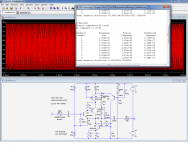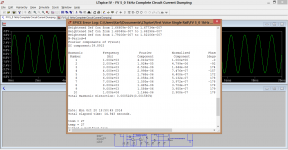You have two Fourier commands active on your schematic; 1kHz and 100kHz. Your sine source is set to100kHz.
You could always ask the man, Mike, directly: <LTspice@linear.com>. I've done that, and got an excellent response, that was very helpful ...
I've just updated and I'm seeing this also.
Hmm.
Code:
Circuit: * Z:\home\tarkus\LTspice files\my files\tube\6CX7-pre\6cx7-pre.asc
Direct Newton iteration for .op point succeeded.
N-Period=1
Fourier components of V(out)
DC component:-0.00200956
Harmonic Frequency Fourier Normalized Phase Normalized
Number [Hz] Component Component [degree] Phase [deg]
1 1.000e+03 2.827e+00 1.000e+00 179.94° 0.00°
2 2.000e+03 4.569e-03 1.616e-03 89.62° -90.33°
3 3.000e+03 2.659e-05 9.403e-06 -1.13° -181.08°
4 4.000e+03 7.972e-07 2.820e-07 -150.40° -330.35°
5 5.000e+03 5.517e-07 1.951e-07 179.99° 0.04°
6 6.000e+03 4.565e-07 1.615e-07 179.99° 0.05°
7 7.000e+03 3.915e-07 1.385e-07 180.00° 0.05°
8 8.000e+03 3.427e-07 1.212e-07 180.00° 0.05°
9 9.000e+03 3.048e-07 1.078e-07 180.00° 0.05°
Total Harmonic Distortion: 0.161606%(0.161605%)
Date: Mon Oct 20 18:39:45 2014
Total elapsed time: 2.411 seconds.
tnom = 27
temp = 27
method = modified trap
totiter = 196676
traniter = 196666
tranpoints = 98334
accept = 98332
rejected = 2
matrix size = 14
fillins = 0
solver = Normal
Matrix Compiler1: 840 bytes object code size 1.5/1.4/[1.2]
Matrix Compiler2: 1.10 KB object code size 1.3/1.4/[1.2]Seems like it's defaulting to the 9th ".four 1k V(out)". When I specify ".four 1k 10 10 V(out)", it goes out to the 10th.
Mike Engelhardt very kindly replied to me asking what was going on and the answer is...
The 2nd figure an alternative method of computing THD. It nominally includes
all harmonics but numerically difficulting in identifying the fundamental
limits it actually use. It's just bonus information for the guy that asked for
the feature. You can ignore it. But is the number is higher the previous
number, it is an indication that you didn't include enough harmonics in
your THD calculation.
The 2nd figure an alternative method of computing THD. It nominally includes
all harmonics but numerically difficulting in identifying the fundamental
limits it actually use. It's just bonus information for the guy that asked for
the feature. You can ignore it. But is the number is higher the previous
number, it is an indication that you didn't include enough harmonics in
your THD calculation.
Quite strange: in the example I gave, the second figure is actually lower than the first (zero in fact)Mike Engelhardt very kindly replied to me asking what was going on and the answer is...
The 2nd figure an alternative method of computing THD. It nominally includes
all harmonics but numerically difficulting in identifying the fundelmental
limits it actually use. It's just bonus information for the guy that asked for
the feature. You can ignore it. But is the number is higher the previous
number, it is an indication that you didn't include enough harmonics in
your THD calculation.
Elvee, please send your schematic to Mike so he can look at the results. It seems there is clearly something wrong if the second number is vastly lower than the first number.
EDIT: Mike's explanation is full of grammar errors and very unclear. You must have caught him at a bad time. Maybe it's normal to have the second number lower for certain reasons but because of this I can't tell. Perhaps if the harmonics are buried in DC drift the second number can be lower and more accurate? Need more information...
EDIT: Mike's explanation is full of grammar errors and very unclear. You must have caught him at a bad time. Maybe it's normal to have the second number lower for certain reasons but because of this I can't tell. Perhaps if the harmonics are buried in DC drift the second number can be lower and more accurate? Need more information...
Last edited:
Quite strange: in the example I gave, the second figure is actually lower than the first (zero in fact)
Probably due to 'computational folding'.
Try changing numdgt to see if you get a different result.
Doesn't change a thing:Try changing numdgt to see if you get a different result.
Attachments
- Status
- Not open for further replies.
- Home
- Design & Build
- Software Tools
- What's LTspice doing there?


